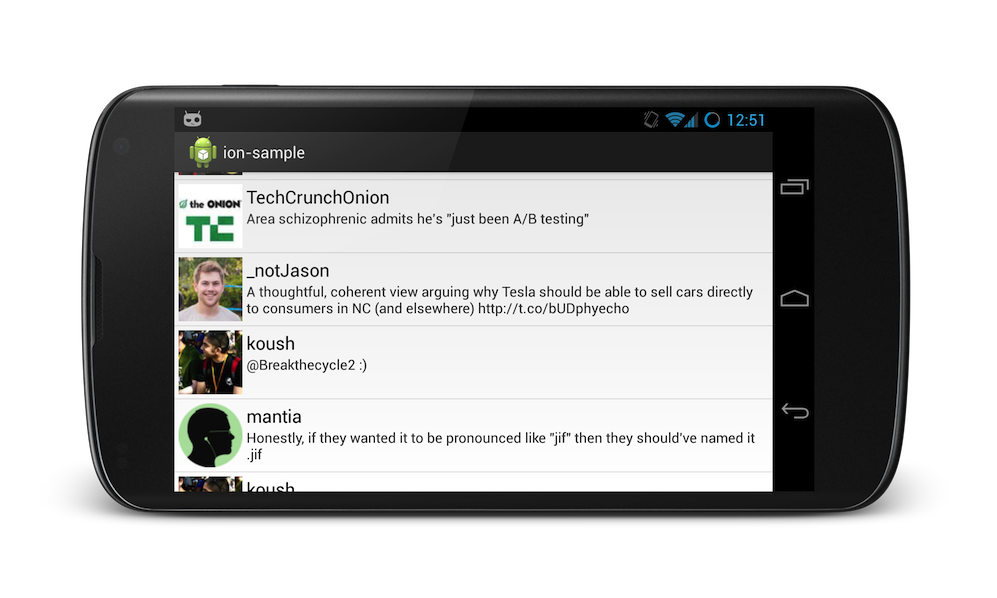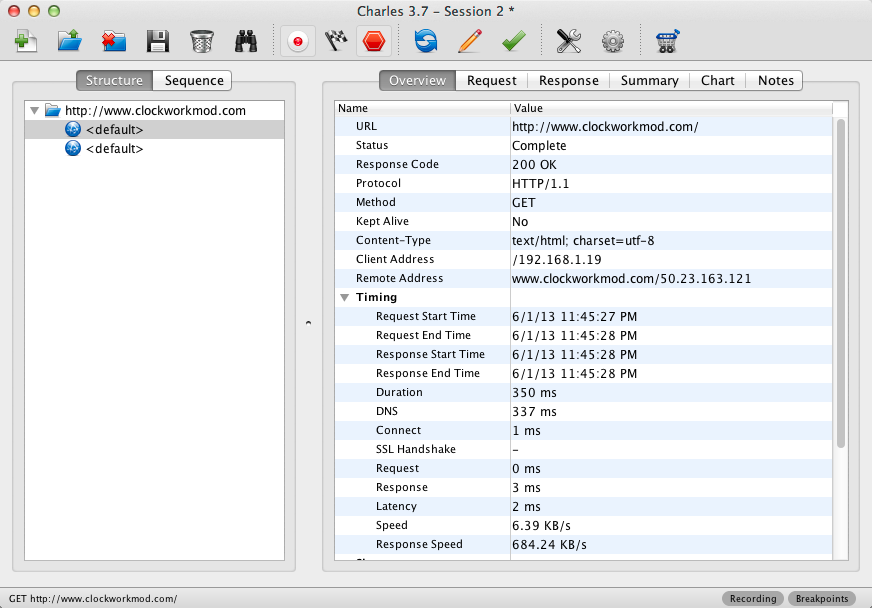Android Asynchronous Networking and Image Loading
Download
Features
- Asynchronously download:
- Easy to use Fluent API designed for Android
- Automatically cancels operations when the calling Activity finishes
- Manages invocation back onto the UI thread
- All operations return a Future and can be cancelled
- HTTP POST/PUT:
- text/plain
- application/json - both JsonObject and POJO
- application/x-www-form-urlencoded
- multipart/form-data
- Transparent usage of HTTP features and optimizations:
- Caching
- Gzip/Deflate Compression
- Connection pooling/reuse via HTTP Connection: keep-alive
- Uses the best/stablest connection from a server if it has multiple IP addresses
- Cookies
- View received headers
- Grouping and cancellation of requests
- Download progress callbacks
- Supports file:/, http(s):/, and content:/ URIs
- Request level logging and profiling
- Support for proxy servers like Charles Proxy to do request analysis
- Based on NIO and AndroidAsync
- Ability to use self signed SSL certificates
Samples
The included documented ion-sample project includes some samples that demo common Android network operations:
- Twitter Client Sample
- Download JSON from a server (twitter feed)
- Populate a ListView Adapter and fetch more data as you scroll to the end
- Put images from a URLs into ImageViews (twitter profile pictures)
- File Download with Progress Bar Sample
- Get JSON and show images with the Google Image Search Sample
More Examples
Looking for more? Check out the examples below that demonstrate some other common scenarios. You can also take a look at 30+ ion unit tests in the ion-test.
Get JSON
Ion.with(context)
.load("http://example.com/thing.json")
.asJsonObject()
.setCallback(new FutureCallback<JsonObject>() {
@Override
public void onCompleted(Exception e, JsonObject result) {
// do stuff with the result or error
}
});Post JSON and read JSON
JsonObject json = new JsonObject();
json.addProperty("foo", "bar");
Ion.with(context)
.load("http://example.com/post")
.setJsonObjectBody(json)
.asJsonObject()
.setCallback(new FutureCallback<JsonObject>() {
@Override
public void onCompleted(Exception e, JsonObject result) {
// do stuff with the result or error
}
});Post application/x-www-form-urlencoded and read a String
Ion.with(getContext(), "https://koush.clockworkmod.com/test/echo")
.setBodyParameter("goop", "noop")
.setBodyParameter("foo", "bar")
.asString()
.setCallback(...)Post multipart/form-data and read JSON with an upload progress bar
Ion.with(getContext(), "https://koush.clockworkmod.com/test/echo")
.uploadProgressBar(uploadProgressBar)
.setMultipartParameter("goop", "noop")
.setMultipartFile("filename.zip", new File("/sdcard/filename.zip"))
.asJsonObject()
.setCallback(...)Download a File with a progress bar
Ion.with(context)
.load("http://example.com/really-big-file.zip")
// have a ProgressBar get updated automatically with the percent
.progressBar(progressBar)
// and a ProgressDialog
.progressDialog(progressDialog)
// can also use a custom callback
.progress(new ProgressCallback() {@Override
public void onProgress(int downloaded, int total) {
System.out.println("" + downloaded + " / " + total);
}
})
.write(new File("/sdcard/really-big-file.zip"))
.setCallback(new FutureCallback<File>() {
@Override
public void onCompleted(Exception e, File file) {
// download done...
// do stuff with the File or error
}
});Setting Headers
Ion.with(context)
.load("http://example.com/test.txt")
// set the header
.setHeader("foo", "bar")
.asString()
.setCallback(...)Load an image into an ImageView
// This is the "long" way to do build an ImageView request... it allows you to set headers, etc.
Ion.with(context)
.load("http://example.com/image.png")
.withBitmap()
.placeholder(R.drawable.placeholder_image)
.error(R.drawable.error_image)
.animateLoad(spinAnimation)
.animateIn(fadeInAnimation)
.intoImageView(imageView);
// but for brevity, use the ImageView specific builder...
Ion.with(imageView)
.placeholder(R.drawable.placeholder_image)
.error(R.drawable.error_image)
.animateLoad(spinAnimation)
.animateIn(fadeInAnimation)
.load("http://example.com/image.png");The Ion Image load API has the following features:
- Disk and memory caching
- Bitmaps are held via weak references so memory is managed very effeciently
- ListView Adapter recycling support
- Bitmap transformations via the .transform(Transform)
- Animate loading and loaded ImageView states
- DeepZoom for extremely large images
Futures
All operations return a custom Future that allows you to specify a callback that runs on completion.
public interface Future<T> extends Cancellable, java.util.concurrent.Future<T> {
/**
* Set a callback to be invoked when this Future completes.
* @param callback
* @return
*/
public Future<T> setCallback(FutureCallback<T> callback);
}
Future<String> string = Ion.with(context)
.load("http://example.com/string.txt")
.asString();
Future<JsonObject> json = Ion.with(context)
.load("http://example.com/json.json")
.asJsonObject();
Future<File> file = Ion.with(context)
.load("http://example.com/file.zip")
.write(new File("/sdcard/file.zip"));
Future<Bitmap> bitmap = Ion.with(context)
.load("http://example.com/image.png")
.intoImageView(imageView);Cancelling Requests
Futures can be cancelled by calling .cancel():
bitmap.cancel();
json.cancel();Blocking on Requests
Though you should try to use callbacks for handling requests whenever possible, blocking on requests is possible too. All Futures have a Future.get() method that waits for the result of the request, by blocking if necessary.
JsonObject json = Ion.with(context)
.load("http://example.com/thing.json").asJsonObject().get();Seamlessly use your own Java classes with Gson
public static class Tweet {
public String id;
public String text;
public String photo;
}
public void getTweets() throws Exception {
Ion.with(context)
.load("http://example.com/api/tweets")
.as(new TypeToken<List<Tweet>>(){})
.setCallback(new FutureCallback<List<Tweet>>() {
@Override
public void onCompleted(Exception e, List<Tweet> tweets) {
// chirp chirp
}
});
}Logging
Wondering why your app is slow? Ion lets you do both global and request level logging.
To enable it globally:
Ion.getDefault(getContext()).configure().setLogging("MyLogs", Log.DEBUG);Or to enable it on just a single request:
Ion.with(context)
.load("http://example.com/thing.json")
.setLogging("MyLogs", Log.DEBUG)
.asJsonObject();Log entries will look like this:
D/MyLogs(23153): (0 ms) http://example.com/thing.json: Executing request.
D/MyLogs(23153): (106 ms) http://example.com/thing.json: Connecting socket
D/MyLogs(23153): (2985 ms) http://example.com/thing.json: Response is not cacheable
D/MyLogs(23153): (3003 ms) http://example.com/thing.json: Connection successful
Request Groups
By default, Ion automatically places all requests into a group with all the other requests created by that Activity or Service. Using the cancelAll(Activity) call, all requests still pending can be easily cancelled:
Future<JsonObject> json1 = Ion.with(activity, "http://example.com/test.json").asJsonObject();
Future<JsonObject> json2 = Ion.with(activity, "http://example.com/test2.json").asJsonObject();
// later... in activity.onStop
@Override
protected void onStop() {
super.onStop();
Ion.getDefault(activity).cancelAll(activity);
}Ion also lets you tag your requests into groups to allow for easy cancellation of requests in that group later:
Object jsonGroup = new Object();
Object imageGroup = new Object();
Future<JsonObject> json1 = Ion.with(activity, "http://example.com/test.json")
// tag in a custom group
.group(jsonGroup)
.asJsonObject();
Future<JsonObject> json2 = Ion.with(activity, "http://example.com/test2.json")
// use the same custom group as the other json request
.group(jsonGroup)
.asJsonObject();
Future<Bitmap> image1 = Ion.with(activity, "http://example.com/test.png")
// for this image request, use a different group for images
.group(imageGroup)
.intoImageView(imageView1);
Future<Bitmap> image2 = Ion.with(activity, "http://example.com/test2.png")
// same imageGroup as before
.group(imageGroup)
.intoImageView(imageView2);
// later... to cancel only image downloads:
Ion.getDefault(activity).cancelAll(imageGroup);Proxy Servers (like Charles Proxy)
Proxy server settings can be enabled all Ion requests, or on a per request basis:
// proxy all requests
Ion.getDefault(context).configure().proxy("mycomputer", 8888);
// or... to proxy specific requests
Ion.with(context)
.load("http://example.com/proxied.html")
.proxy("mycomputer", 8888)
.getString();Using Charles Proxy on your desktop computer in conjunction with request proxying will prove invaluable for debugging!
Viewing Received Headers
Ion operations return a ResponseFuture, which grant access to response properties via the Response object. The Response object contains the headers, as well as the result:
Ion.with(getContext())
.load("http://example.com/test.txt")
.asString()
.withResponse()
.setCallback(new FutureCallback<Response<String>>() {
@Override
public void onCompleted(Exception e, Response<String> result) {
// print the response code, ie, 200
System.out.println(result.getHeaders().getResponseCode());
// print the String that was downloaded
System.out.println(result.getResult());
}
});Get Ion
Jars
- androidasync.jar (dependency)
- ion.jar
Maven
<dependency>
<groupId>com.koushikdutta.ion</groupId>
<artifactId>ion</artifactId>
<version>1,</version>
</dependency>Gradle
dependencies {
compile 'com.koushikdutta.ion:ion:1.+'
}Local Checkout (with AndroidAsync dependency)
git clone git://github.com/koush/AndroidAsync.git
git clone git://github.com/koush/ion.git
cd ion/ion
ant -Dsdk.dir=$ANDROID_HOME release install
Jars are at
- ion/ion/bin/classes.jar
- AndroidAsync/AndroidAsync/bin/classes.jar
Hack in Eclipse
git clone git://github.com/koush/AndroidAsync.git
git clone git://github.com/koush/ion.git
- Import the project from AndroidAsync/AndroidAsync into your workspace
- Import all the ion projects (ion/ion, ion/ion-test, ion/ion-sample) into your workspace.
Projects using ion
There's hundreds of apps using ion. Feel free to contact me or submit a pull request to add yours to this list.

